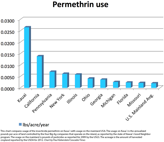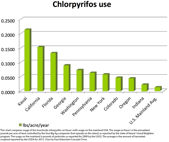Blogger's note, October 1, 2014: An exchange about the accuracy of the Cascadia Times report referred to below is taking place between its author and the Hawaii Crop Improvement Association, the trade group of the chemical+seed industry. It is important to note that the estimate comparisons made by Cascadia Times remain only estimates, based on imprecise data, and that the industry has not been willing to provide more precise data. While Kauai’s “ranking” in comparative pounds-per-acre intensity of pesticide use may be slightly lower or higher than the Cascadia Times estimates, the most critical point remains that pesticide disclosure from the “Good Neighbor Program” reveals very large amounts of restricted use pesticides (RUPs) being used by the chemical+seed companies.
*****
The following is taken from a press release sent out by the Kauai Coalition to Enforce Ordinance 960, which I am a part of. I have written about Ordinance 960, previously Bill 2491, in this blog and elsewhere. The Kauai County bill, mandating pesticide disclosure and buffer zones, is set to go into effect in August. Shamelessly, the chemical companies have sued to keep residents in the dark about the pesticides they are being exposed to on a daily basis.
Recent reports by Cascadia Times have further revealed the exceptional volume of highly toxic pesticides being used by DuPont Pioneer, Syngenta, Dow and BASF on Kauai, often adjacent to communities and sensitive environmental areas.
An analysis done by Cascadia Times of government pesticide databases and data from the Kauai "Good Neighbor Program" shows that the intensity of pesticide use on Kauai's chemical+GMO test fields "far surpasses the norm at most other American farms," and in such quantities to have transformed parts of the island into "one of the most toxic chemical environments in all of American agriculture." The chemical companies have not provided data for other Hawaiian Islands, but operations on Molokai, Maui and Oahu likely use similarly high levels of pesticides.
The recent data and analysis have strongly reinforced the immediate need for buffer zones, full pesticide disclosure, and investigation into health and environmental impacts of chemical company operations. Kauai County Council member Gary Hooser commented, "Seeing these figures gives a renewed urgency to enforcement of Ordinance 960, and a strong hint as to why the chemical companies are suing us to avoid compliance. They have lied and hidden things all along, and the more we find out, the more concerning it becomes."
The most heavily used restricted-use pesticides are atrazine, permethrin, chlorpyrifos, paraquat, methomyl, metolachlor and alachlor. According to the article, all have been "linked to a variety of serious health problems ranging from childhood cognitive disorders to cancer. And when applied together in a toxic cocktail, their joint action can make them even more dangerous to exposed people."
Per-acre usage of chlorpyrifos and permethrin by the chemical+GMO industry on Kauai was top in the nation by a significant amount, and calculated to be more than 10 times the national average. The analysis also projected that Kauai ranks second nationally for methomyl, fifth for metolachlor, sixth for alachlor, ninth for paraquat and 23rd for atrazine. Figures are not exact because the chemical companies have refused to release precise data about where they are spraying, and intensity of use may actually be much higher given that the companies do not use large portions of the land that they occupy.
The report also points to possible violations of federal law by the chemical companies, including illegal drift and the application of Lorsban (chlorpyrifos) on days with winds blowing over 10 mph, which is strictly prohibited. Chlorpyrifos is a neurotoxin known to injure the developing brain of children.
The Cascadia Times analysis comes on the heels of a report by the Center for Media and Democracy (CMD) shedding light on the influence of the chemical industry on Hawaii politics. CMD documents that over $50,000 was spent by the industry lobbying state lawmakers while they were considering the "Hawaii Monsanto Protection Act" and other bills to strip counties of their regulatory rights. The industry contributed at least over $700,000 to state and county candidates from November 2006 through December 2013.
The connection between the chemical industry's deep and widespread influence in Hawaii, and a regulatory system that fails to protect people's health and the environment, is of grave concern to residents.
"We refuse to be casualties in these corporation's drive to sell more and more pesticides," said Lorilani Keohokalole-Torio. "While they are establishing global monopolies in chemicals and seeds, locally they are occupying and poisoning our land, people, and democracy. But we are idle no more, and will protect what we love."

